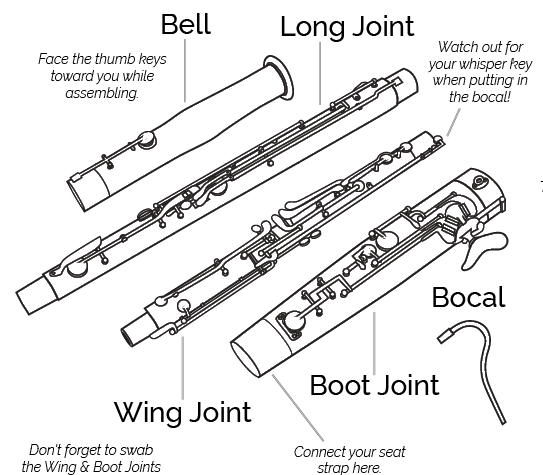What’s Wrong With My Bassoon?
Process for Diagnosing Problems with Your Bassoon
Sometimes it’s really obvious when something is broken on your bassoon, maybe a pad fell off or you can see that the joints don’t fit together. If you just need a quick fix, check out my post on emergency repair for bassoon. However, since the key work on the bassoon is complex, sometimes problems are not as obvious. Below you’ll find a quick method for diagnosing problems with your bassoon along with suggested fixes.
🔍HOw to diagnose problems with the bassoon
It can be overwhelming to try to fix a bassoon. With over 20 keys, it's hard to know where to start. Here is my "order of operations" for diagnosing a problem.
After a thorough examination of your instrument, you will be able to decide if you can fix it yourself or if you need to work with a repair specialist.
Follow this list in order to pinpoint the issue. Don’t skip any steps!
Play the instrument. Try some slow even scales that go up and down the range of the instrument. Then try a small section of a piece. Make a note of what is or isn't working. Listen for air leaking from pads and try to notice if the keys are lifting and lowering correctly.
Check the reed. If it is discolored, cracked, chipped, or really old, throw it away. If it is too open or too closed, adjust the tip opening by using pliers on the first wire (nearest to the lips). Check out this post for more ideas on adjusting reeds.
Check the bocal. It should look like a normal bocal and not be bent, dented, cracked, or leaking anywhere. The cork should fit comfortably in the bassoon with no squeaking when inserted.
Visually inspect the bassoon working from the smallest to the largest piece of the instrument to see if there are loose or missing pads, loose or missing screws, or springs out of place. Start with the wing joint, then the long joint, then the boot joint. Look inside the bassoon to make sure nothing is stuck in the instrument. Press each key individually to make sure they all open and close like they are supposed to. If you aren’t sure, try comparing your bassoon to another working bassoon to see which keys aren’t functioning properly.
If you don't see anything wrong, make a list of what specifically isn't working or what sounds off and have someone else play test the instrument for good measure. Try playing a scale from a low note to a high note. Do the notes cut out at a particular spot? Is there a single note that is bothering you? Send the bassoon along with those notes to the repair shop and be sure to test it when it returns.
✔ Trouble Shooting Shortcuts
Here are some common problems and their causes. Often issues are caused by the player or the reed, but mechical issues with the instrument can also occur.
High notes are hard to play
The reed is too new, too wide, or too open.
Not using enough air support, air pressure, or the correct vocalization for high notes.
The bocal is clogged with spit or debris. Check the nib on the side of the bocal and clean it carefully with a small wire, nothing bigger than the hole!
Low notes are hard to play
The reed is damaged, too closed, or too old.
The bocal is leaking/cracked or not fitting properly.
The pancake key isn't closing the whisper key fully.
A pad or spring is out of place higher on the bassoon causing air to leak somewhere.
Nothing below Bass Clef C comes out
The bocal is leaking or damaged. Visually inspect the bocal. Then plug one end with your finger, cover the nib on the side and blow in to see if there is air leaking anywhere.
One of the flick keypads has fallen off, causing a leak in the wing joint. Check the keys and replace the missing pad with a cork pad.
Everything is hard to play and feels resistant
Problems with response or cracking are almost always a problem with the reed or the bocal. Check the reed for cracks, discoloration, etc., and check the bocal for cracks, dents, and leaks.
random notes seem Off or notes sound growly
If everything feels normal except for a few random notes or some growly sounding notes, a pad is probably loose, stuck, or missing from the boot joint. Pads in the boot joint often get stuck closed due to moisture from playing (and not swabbing). Check the pads at the very bottom of the boot (G, A-flat, F-sharp keys) and unstick as needed. Use cigarette paper to dry the pad, add a bit of baby powder if you'd like to help prevent sticking.
If you discover that your bassoon needs a repair, check out my emergency bassoon repair guide to see if you can DIY it or if you need to see a specialist.



